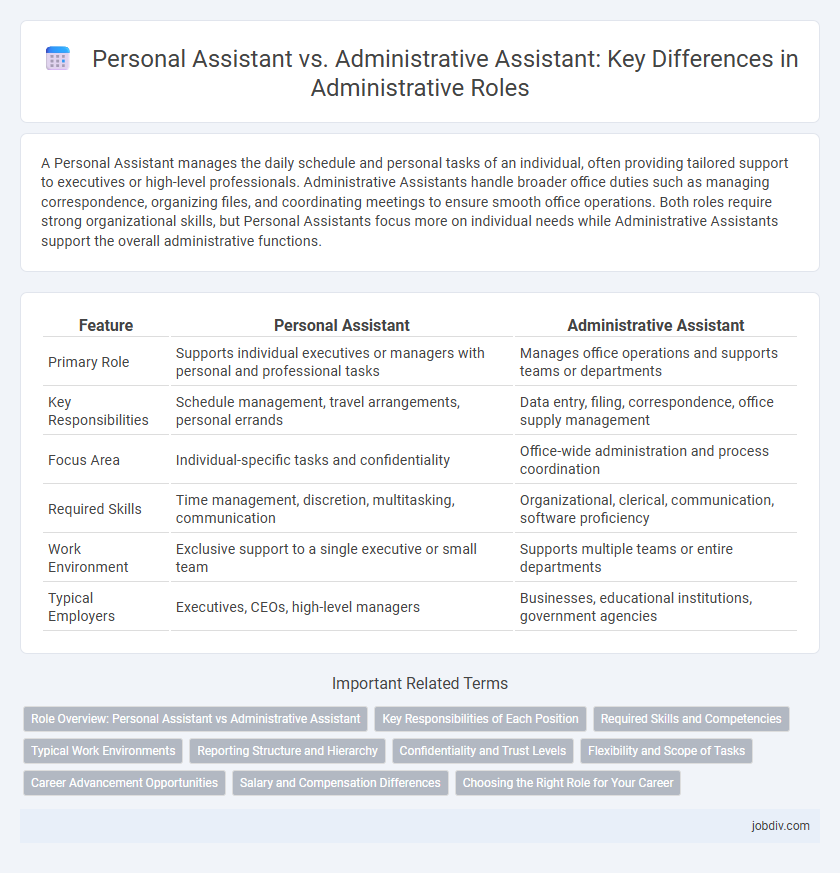A Personal Assistant manages the daily schedule and personal tasks of an individual, often providing tailored support to executives or high-level professionals. Administrative Assistants handle broader office duties such as managing correspondence, organizing files, and coordinating meetings to ensure smooth office operations. Both roles require strong organizational skills, but Personal Assistants focus more on individual needs while Administrative Assistants support the overall administrative functions.
Table of Comparison
| Feature | Personal Assistant | Administrative Assistant |
|---|---|---|
| Primary Role | Supports individual executives or managers with personal and professional tasks | Manages office operations and supports teams or departments |
| Key Responsibilities | Schedule management, travel arrangements, personal errands | Data entry, filing, correspondence, office supply management |
| Focus Area | Individual-specific tasks and confidentiality | Office-wide administration and process coordination |
| Required Skills | Time management, discretion, multitasking, communication | Organizational, clerical, communication, software proficiency |
| Work Environment | Exclusive support to a single executive or small team | Supports multiple teams or entire departments |
| Typical Employers | Executives, CEOs, high-level managers | Businesses, educational institutions, government agencies |
Role Overview: Personal Assistant vs Administrative Assistant
A Personal Assistant primarily manages the daily schedule, correspondence, and personal tasks of an individual executive, ensuring seamless organization and time management. An Administrative Assistant offers broader office support, including handling communications, organizing meetings, and maintaining records across teams or departments. Both roles require strong organizational skills but differ in scope, with Personal Assistants focusing on individual executives and Administrative Assistants supporting wider office operations.
Key Responsibilities of Each Position
Personal Assistants primarily manage executives' schedules, coordinate meetings, handle correspondence, and organize travel arrangements to ensure seamless day-to-day operations. Administrative Assistants focus on office management tasks such as maintaining records, preparing reports, managing office supplies, and supporting team communication to enhance overall organizational efficiency. Both positions require excellent organizational and communication skills but differ in scope, with Personal Assistants providing more personalized support and Administrative Assistants handling broader office functions.
Required Skills and Competencies
Personal Assistants require excellent organizational skills, discretion, and strong interpersonal communication to manage executive schedules and personal tasks efficiently. Administrative Assistants need proficiency in office software, multitasking abilities, and attention to detail to handle clerical duties, documentation, and office operations. Both roles demand adaptability, time management, and problem-solving skills to support seamless workflow and executive productivity.
Typical Work Environments
Personal Assistants typically work in private offices or home settings, providing tailored support to executives or individuals, often managing personal and professional tasks. Administrative Assistants are commonly found in corporate offices, government agencies, or educational institutions, handling a broad range of clerical duties that support entire departments or teams. Both roles require proficiency in office software and excellent organizational skills but differ significantly in their work environment scope and direct reporting structures.
Reporting Structure and Hierarchy
A Personal Assistant typically reports directly to a high-level executive or individual, operating within a more personalized and confidential capacity, whereas an Administrative Assistant usually supports a department or team under a manager or supervisor within a broader organizational hierarchy. Personal Assistants often have a flatter reporting structure with direct access to decision-makers, while Administrative Assistants function within a more layered hierarchy involving multiple levels of oversight. Understanding these distinctions in reporting structure and hierarchy is crucial for aligning responsibilities and workflow in corporate administration.
Confidentiality and Trust Levels
Personal Assistants often handle highly confidential information, managing their employer's private schedules, communications, and sensitive documents, which requires an exceptional level of trust and discretion. Administrative Assistants support broader office functions and may have access to confidential company data but typically deal with less personal and more operational information. Both roles demand strong confidentiality practices, yet the trust level for Personal Assistants is generally higher due to the intimate nature of their responsibilities.
Flexibility and Scope of Tasks
Personal assistants typically offer greater flexibility, adapting their schedules and tasks to the specific needs of an individual executive, including managing personal errands and highly confidential matters. Administrative assistants focus on broader organizational support, handling tasks like scheduling meetings, preparing reports, and coordinating office operations across departments. The scope of tasks for personal assistants is more personalized and variable, while administrative assistants manage consistent, structured administrative duties within a company.
Career Advancement Opportunities
Career advancement opportunities for Personal Assistants often involve roles with increasing responsibility in executive support or transitioning into project management positions, leveraging their close work with senior leaders. Administrative Assistants typically progress into office management, operations coordination, or specialized administrative roles within departments, focusing on organizational efficiency. Both career paths offer growth through skill development in communication, time management, and technology proficiency.
Salary and Compensation Differences
Personal Assistants typically earn between $40,000 and $65,000 annually, reflecting their close support to executives with specialized tasks, whereas Administrative Assistants have a broader role with salaries ranging from $35,000 to $55,000. Compensation packages for Personal Assistants often include bonuses and perks aligned with executive-level support, such as flexible work arrangements and performance incentives. Administrative Assistants generally receive standard benefits like health insurance and paid leave, with less frequent opportunities for bonuses or commissions.
Choosing the Right Role for Your Career
Personal Assistants manage executives' daily schedules, prioritize tasks, and handle confidential information, focusing on individualized support. Administrative Assistants oversee office operations, coordinate communication across departments, and organize company events, emphasizing organizational efficiency. Choosing the right role depends on your career goals: seek a Personal Assistant position if you prefer close executive interaction, or an Administrative Assistant role for broader organizational responsibilities.
Personal Assistant vs Administrative Assistant Infographic

 jobdiv.com
jobdiv.com